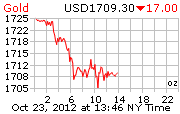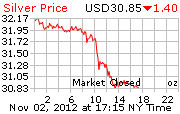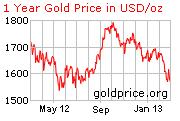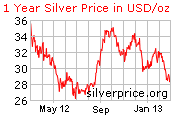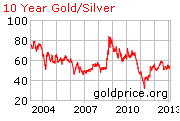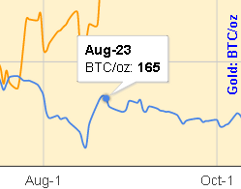Archive
$1764 (Updated)
-
One Seven Six Four
-
Jim Sinclair commented that when gold breaches $1764, it signals the start of Phase 3 of the bull market and the price is expected to go exponential. Gold was around $1660 when the interview was recoded on 5th August 2010 at the GATA conference in London.
-
The $1764 Gold battle line has been drawn, and for the past 24 hours, gold has been repeatedly testing that level for the first time.
-
Looks like we’ll know soon enough if gold will close above this critical number.
-
Updated: 11 Aug 2011
Gold indeed closed above that $1764 battle line number last night:
| London PM Fix: | $1772 |
| Comex Close: | $1781 |
| Globex Close: | $1798 |
| HKMEx: | $1775 |
So, if Sinclair is right on this call, as he has often been in the past, expect gold to print some interesting numbers on the charts going forward into phase 3 of the gold bull market. According to James Turk, gold went into Phase 2 when it crossed $1000 around November 2009.
After leading gold since Aug 2010 when the Gold/Silver ratio (GSR) was around 65 until the May 1 cartel-orchestrated price take-down (GSR at 32), silver has been playing catching up lately. 18 minutes into this interview with Eric Sprott, James Turk, founder of GoldMoney commented that he believes silver is still in Phase 1 and will not enter Phase 2 until it crosses $50 (its 1980 high). If you think you’re a little late in gold and feeling nervous about jumping into the bandwagon around it’s all time nominal high, silver may offer an easier entry point. But as most hard currency adherents would advise, have a healthy ratio between both monetary metals.
Notwithstanding the euphoria of breaking through the much watched “$1764 Gold” number, extreme volatility in both directions for both PMs is to be expected. Gene Arensberg, in his latest Got Gold Report commented that the Large Commercial Net Short (LCNS) position is near its all time high but he can’t predict whether these BIG Commercial short sellers will push gold and silver back down or get overrun this time. If it’s the former, we’ll see another take down. If the latter, the short covering and new buying arising from the flight to safety crowd will cause Sinclair’s forecast to be cast in gold!
GotGoldReport Chart: Gold LCNS, Source CFTC for COT data, Cash market for gold
AC5HKFK2YTJ5
Updated: 12 Aug 2011
Comex gold closes $66/oz off record high as stocks rise, CME increases margins
-Updated August 12
Like this:
Gold is NOT an Investment. If you’re Looking for an Investment, Look Elsewhere.
In the “About” page, I listed 5 points forming the theme of this website, which was set up to share my personal experience in discovering that the debt-based financial world as we know it today is one gigantic Ponzi scheme. That it was designed to work against people who’ve expended labour to earn in excess of what they needed, saving that surplus for a time in the future when they could no longer exchange labour for the daily necessities of life.
The first of my 5 points was Do not invest in gold or silver. Own them in place of Fiat Money.
Distinguishing between investing and owning gold (or silver) goes beyond semantics. It lies at the core of why so many are still reluctant to make gold or silver a part of their asset portfolio despite the financial turmoil and uncertainties surrounding them. Owning gold is not meant to make you richer. It protects you from getting poorer due to rising inflation. It preserves what you already have - performing that critical function of money (Store of Value) better than any other forms of money available today.
The idea of not investing in gold is not my original idea. It’s a concept I learnt from many who’s been in this space long before I discovered that gold is money. The recent presentation given by James Turk, founder of GoldMoney, at the 2011 Munich DEG conference on 29th April 2011 explains this concept very eloquently.
Also reproduced below are some charts appearing in the video for your easy reference. (They were from a previous presentation made a few months earlier)
Exchange rates of gold & other currencies over the past 10 years
Gold (the Green Portion) is not an investment
Price of Crude Oil in GBP, USD, EUR and Goldgrams
Stocks measured in Gold
The implications for the fiat currency
Gold in GBP. Similar charts in USD, GBP, EUR & SFR display the same parabolic up trend
-
Q&A after the presentation
The EXIT $ign

In recent times, major institutions are running to the EXIT. The most famous of which was how The University of Texas Investment Management Company took delivery of almost $1 billion in gold bullion, and that’s because
“Central banks are printing more money than they ever have, so what’s the value of money in terms of purchases of goods and services,” Bass said today in a telephone interview. “I look at gold as just another currency that they can’t print any more of”.
Groups of nations are running to the EXIT. I highlighted one of the more significant runs in this post Another new writing on the wall - BRICS dump the USD.
Brazil, Russia, India, China and South Africa – the BRICS group of fastest growing economies – Thursday signed an agreement to use their own currencies instead of the predominant US dollar in issuing credit or grants to each other.
Yesterday, it was reported that Mexico saw smoke coming from her northern neighbour and headed for the exit, big time! Considering how many other nations (China, Russia, Thailand, Belarus, Bangladesh, Venezuela, Tajikistan, Ukraine, Jordan, Philippines, South Africa, Sri Lanka, Germany, Kazakhstan, Mexico, Greece, Pakistan, Belgium, Czech Republic, Mauritius and Malta) have been running towards the exit since 2009, Mexico’s Central Bank wasted no time to catch up, as illustrated by this very pretty chart.

-
MEXICO CITY, May 4 (Reuters) - Mexico massively ramped up its gold reserves in the first quarter of this year, buying over $4 billion of bullion as emerging economies move away from the ailing U.S. dollar, which has dipped to 2-1/2-year lows.The third biggest one-off purchase of gold by any country over the past decade took Mexico’s reserves to 100.15 tonnes - or 3.22 million ounces - by the end of March from just 6.84 tonnes at the end of January, according to the International Monetary Fund and Mexico’s central bank.
…… Credit Suisse precious metals analyst Tom Kendall said it was worthy of note that Mexico, whose economy is very closely tied to the United States, had taken this step.
“The size (of the purchase) is certainly pretty chunky to have been accomplished in that space of time. So it certainly gives another sizable layer of support to gold’s position in the international reserves system,” he added.
George Milling-Stanley, managing director of government affairs at the World Gold Council industry group, said Mexico was following a recent trend among central banks to restore a “prior balance between gold and currency reserves.”
“This is further supported by the fact that the May IMF numbers show continued buying by Russia and Thailand of 18.8 tonnes and 9.3 tonnes respectively,” he added.
Mexico’s reserves rank it 33rd among the top official holders of gold. The United States is the largest official holder of gold, with 8,133 tonnes, which account for 73.8 percent of its total international reserves.
China is the sixth largest holder of gold, with 1,054.1 tonnes, or just 1.6 percent of total reserves, while eighth-ranked Russia now has some 811 tonnes of gold, up from 788.78 in January, according to the IMF data.
Silver, which hit a record price earlier this year, may also have been on Mexico’s buying list, said Martin at HSBC.

Premier Wen Jiabao shakes hands with his Russian counterpart Vladimir Putin
Going back to November last year, recall how China Daily reported that
“China and Russia have decided to renounce the US dollar and resort to using their own currencies for bilateral trade, Premier Wen Jiabao and his Russian counterpart Vladimir Putin announced late on Tuesday.”
Well, just as Mexico was reported playing catching up yesterday, Japan and South Korea did not want to be left behind in the multi-lateral Dump USD game either. WSJ reported:
May 3, HANOI—Finance ministers from China, Japan and South Korea said in a joint statement Wednesday they have agreed to start studying the use of their own currencies in trade settlement, the latest sign of Asian efforts to reduce dependence on the U.S. dollar.
The ministers from the three big Asian economies also said they are “mindful of” challenges such as growing inflationary pressures in Asia, rising global commodity prices and increasingly volatile capital flows into the region.
Blocks of Nations, individual nations, institutions, and individuals are all heading to the EXIT sign or have already exited the world reserve [paper] currency. They are doing so because the writing is already on the wall. The “Waterfall Decline” event that James Turk, founder of GoldMoney predicts seems to be approaching fast. They exit because they’ve lost confidence in the once almighty USD.
But, if the exit is into monetary metals gold and silver, why are we witnessing the sudden “Waterfall Decline” in the monetary metals instead of the USD? The only sane way to look at this insane price action is to understand that they are Political Metals whose prices are being manipulated by political powers through their Gold and Banking Cartels. The best way to exit your paper currency is to hold gold and silver, not invest in them. View them as owning another currency rather than buying them as an investment.
Related Reads:
- Silver might crash?
- COMEX and London Bullion Market Exchange are at heightened risk of default
- Fluctuations and Trends In the Comex Silver Inventory
- Gold Manipulation
- Silver Manipulation
- and many other articles throughout this site and blog
Like this:
G-10 Committee Meeting Minutes released to GATA by the Fed, as ordered by U.S. District Court judge Ellen Segal Huvelle.

Judge Ellen Segal Huvelle - US District Court, District of Columbia
True to its form, the US federal Reserve (Fed) continues to operate in secrecy just as it was conceived way back in 1910 on Jekyll Island.
The Gold Anti-Trust Action Committee (GATA) sent two letters, one on December 2007 and another on April 2009, to the Fed board requesting the central bank’s records of its market intervention to suppress the price of gold (specifically “gold swaps” related documents). Both requests were denied, despite appeals.
After the unsuccessful attempts to obtain such records under the Freedom-of-Information Act (FOIA), GATA filed a lawsuit against the Fed Board seeking a court order for disclosure of some specific documents on 30th December 2009.
On 3rd February 2011, judge Ellen Segal Huvelle of U.S. District Court for the District of Columbia ruled that most of the Fed’s documents were exempt from disclosure under the FOIA for being “pre-decisional or deliberative”. However, she ordered the disclosure of one document - “a staff member’s notes on the discussion by the Gold and Foreign Exchange Committee of the Group of Ten (or “G-10″), as well as a transmission memorandum from Mr. [Ted] Truman to the board” , and that it be handed over to the plaintiff by February 18.
The very fact that there existed a Gold and Foreign Exchange Committee at the G-10 level suggests that gold is high up the agenda of central banks, rather than being a “barbaric relic” as some would have us believe. Reproduced below is Chris Powell, GATA’s secretary/treasurer’s comments on the minutes of this meeting held on 7th April 1997 that the Fed has been refusing to release until now.
They quote a British delegate as saying that while the gold price seemed “sluggish,” the gold market itself was actually showing “resilience” and “physical demand is high.” The British delegate described the gold market as “traditionally secretive.”
The minutes show committee members acknowledging the heavy involvement of central banks in gold leasing, with the British delegate estimating that a year’s worth of gold production already had been sold forward. That was 14 years ago and of course much central bank gold leasing followed until the last year or so.
According to the minutes, the U.S. delegate cited above, identified only as “Fisher” — apparently Peter R. Fisher, head of open market operations and foreign exchange trading for the Federal Reserve Bank of New York — also warned that central bank gold sales and leasing might be construed as positive for gold. The minutes say: “First, he noted that some market cynics viewed central bank activity as a contrary indicator and therefore one had to be conscious of possible feedback effects. Second, he noted that the price of gold, unlike other commodities, had historically not trended toward the cost of production. This seemed to suggest an ongoing supply/demand imbalance. Third, he had the sense that the gold leasing market was an important component in this puzzle, though he did not understand enough about that market, particularly the credit risk aspects of gold lending.”
A Canadian delegate, the minutes say, wondered whether data about the gold market could be trusted — a point much pressed by GATA and others lately.
U.S. delegate Fisher, the minutes say, “explained that U.S. gold belongs to the Treasury. However, the Treasury had issued gold certificates to the Reserve Banks, and so gold (by these means) also appears on the Federal Reserve balance sheet. If there were to be a revaluation of gold, the certificates would also be revalued upwards; however [to prevent the Fed's balance sheet from expanding] this would lead to sales of government securities. So the net benefit to Treasury would need to be carefully calculated, since sales of government securities would expand the public portfolio of government securities and hence also expand the Treasury’s debt-servicing burden.”
This seems to be as candid an acknowledgement as any of the U.S. government’s profound interest in suppressing the price of gold.
Two years after the G-10′s Gold and Foreign Exchange Committee discussed coordinating Western central bank policies toward gold, most of those central banks announced just such a formal mechanism of cooperation, the Washington Agreement on Gold:
http://www.ecb.int/press/pr/date/1999/html/pr990926.en.html
The minutes of the April 1997 meeting of the G-10 Gold and Foreign Exchange Committee, which the Fed sought to conceal, along with the secrecy on which the Fed successfully has insisted for its other gold records, are powerful confirmations of Western central bank interest in controlling the gold market surreptitiously. The minutes have been posted at GATA’s Internet site here:
http://www.gata.org/files/FedMemoG-10Gold&FXCommittee-4-29-1997.pdf
CHRIS POWELL, Secretary/Treasurer
Gold Anti-Trust Action Committee Inc.
Here is ZeroHedge’s take on Fisher’s comments:
Fisher’s comment relates to what would happen to the Fed’s securities portfolio should there be a sudden or gradual revaluation in the price of gold. His conclusion is that in order to keep the Fed’s balance sheet stable, an (acknowledged) surge in the price of gold would lead to a forced selling in Treasurys. Of course, that would mean that the Fed would have to actually value gold at its actual market price, instead of that relic price of $42.22 per ounce. Which means that valuing gold at fair market value would result in dumping over $300 billion in Treasurys, something the Fed can not afford to do at a time when it is engaged in purchasing $100+ billion each month.
To an extent we agree with GATA’s summary of the implication of this statement: “This seems to be as candid an acknowledgement as any of the U.S. government’s profound interest in suppressing the price of gold.” Yes and no. While this is in fact indicative of the Fed’s desire to keep gold price low, it is the case in a world in which the Fed were to see gold as priced at $1,390/ounce. Not at the fake price of $42.22/ounce (perhaps the Fed can sell us some gold at that price?)
Now keep in mind that the Fed discloses the value of its gold stock as $11.041 billion in each weekly H.4.1. If the Fed were to value gold at FMV, the asset side of the Fed’s balance sheet would suddenly balloon by just over $350 billion, as the fair value of the 8,133.5 tonnes of gold allegedly in possession by the US is valued at $361.8 billion. Which of course also means that to account for the surge in paper assets by $350 billion, the Fed would either have to sell a like amount of Treasurys or increase the liabilities side of its balance sheet, by either increasing the Currency in circulation or the Excess bank reserves by a like amount, a result which would increase inflationary expectations by a massive percentage. Both are obviously outcomes that the Fed will fight to the death to avoid.
As for the question of how much of this unauditable gold tonnage is actually there, that’s a different matter entirely.
So yes, thank you JP Morgan for continuing your sworn duty of doing all you have to do, to maintain the Fed’s 4th mandate of suppressing the price of gold, and preserving the myth that there is no inflation in the US. The people of this truly great and democratic nation applaud your efforts.
Finally, this is what I consider a must watch video interview between James Turk of GoldMoney and Chris Powell of GATA, especially if you are new to the political nature of gold & silver and GATA’s work. Listen to what Chris had to say about the FOIA lawsuit, what else is pending besides the disclosure discussed above, the secretive Gold Stabilization Fund (GSF), Gold Reserve Act 1934, what Deutsche Bundesbank (German central bank) had to say about their gold swap operations, central banking secrecy and gold price suppression scheme in general.
For more information on GATA’s work in exposing the central banks’ role in price suppression of PMs, visit www.gata.org
-
Like this:
The Race to Debase
Monitoring the Currency Wars
Most Recent: Australia Interest Rate Cut
|
Currency Wars Simulation |
Most Popular
Most Recent
Archives
Featured Reviews

16Oct: Jeff Clark (Casey Research)
$2,300 gold by January 2014
05Sep: Bill Murphy (GATA)
$50 silver by year end
13Aug: James Turk (GoldMoney)
We won’t see $1580 gold & $27 silver again
12Aug: Bill Murphy's source
We could see a 100% increase in 90 days.
03Aug: HSBC Analysts
Gold to rally above $1,900 by end 2012
05June: David Bond (SilverMiners)
Gold & Silver may bottom at $1,200 & $18
02June: Don Coxe (Coxe Advisors)
Europe to issue Gold-backed Euro Bonds within the next 3 months
21May: Gene Arensberg (GotGoldReport)
Gold and Silver are very close to a bottom, if one has not already been put in last week
>> More forecasts & forecast accuracy
Featured Videos
|
German Central Bank pledged to the Fed never to buy gold again |
|
George Soros: His role in major world events as agent of the British Empire, as told by LarouchYouth |
 Gold & Silver Interviews (KWN)
Gold & Silver Interviews (KWN)
- Here Is Why Gold & Silver Are Set To Explode Going Forward October 28, 2012
- Here Is What Will Fuel The Move Higher In Hard Assets October 27, 2012
- Greyerz - Two Absolutely Incredible & Key Gold Charts October 26, 2012
- Celente - It’s Not Just Germany’s Gold That’s Missing October 26, 2012
- What To Expect With Gold Assaulting $1,700 & Silver At $32 October 26, 2012
- James Turk - The Entire German Gold Hoard Is Gone October 25, 2012
- KWN Update - Here Is A Huge Key To The Markets October 25, 2012
- Currency Wars Continue To Rage & This Is Positive For Gold October 25, 2012
 Finance & Economics
Finance & Economics
- COINTELPRO Techniques for Dilution, Misdirection and Control of an Internet Forum October 29, 2012 George Washington
- What Fiscal Cliff? Obama Planning Another "Tax Cut" Fiscal Stimulus October 28, 2012 Tyler Durden
- Israel Conducts Air Strike On Sudan Missile Base In 'Dry Run' For Iran Attack October 28, 2012 Tyler Durden
- Supersonic Fiscal Free Fall October 28, 2012 Tim Knight from Slope of Hope
- Charting The Undoing Of Credit-Fueled Globalization October 28, 2012 Tyler Durden
- "Algos-Only" Tomorrow As NYSE Shuts Floor Trading Due To Sandy October 28, 2012 Tyler Durden
- On The Fullness And Boldness Of QE's Manipulation Of American's Behavior October 28, 2012 Tyler Durden
- YouNG FRaNKeNSToRM... October 28, 2012 williambanzai7



